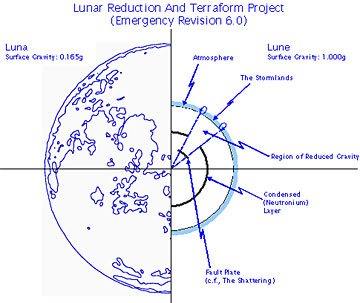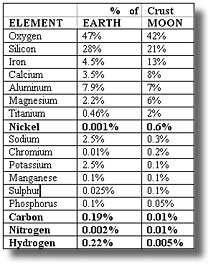June 02, 2005
Why Crush the Moon?
By Wil McCarthy
Ever since Antoine de Saint-Exupéry's 1943 children's novel, The Little Prince, science-fiction writers have dreamed of tiny planets -- planettes, if you will -- wrapped in tiny atmospheres and clothed in plants and cottages, animals and people. Few writers have concerned themselves, though, with the formidable technical details. The first and largest problem is also the most obvious: gravity. Large bodies like the Earth have got a lot of it, while small bodies like asteroids and moons have only a little. On a mile-wide sphere of rock, there's only the faintest tug of attraction; the air and houses and people would simply drift away into outer space. But science offers us an interesting trick here, because a celestial body's surface gravity depends not only on its mass but also on its radius. To put it very simply: a small, dense object puts you closer to the center than a large, fluffy object of equal mass. Hence, gravity's pull is greater.
With a superdense core surrounded by an outer husk of ordinary rock and dirt, it should be possible to build Earthlike gravity into objects just a few meters across. But here you run into two additional problems: tidal forces and escape velocity. "Tide" is basically a word for variations in gravity, and on a small, dense planet these would be very strong. A world the size of a Volkswagen, for example, might pull your feet with one full Earth gravity (1 g or "one gee" in the language of physics), but your head would feel only one-fourth as much! Think of the dizziness, the health problems, the general inconvenience.
The other problem is more serious, because it results in suffocation. "Escape velocity" is the speed an object has to be moving to break free of a gravity well and sail off into interplanetary space. Here on Earth's surface, this speed is a comfortable 11.9 kilometers per second -- enough to keep us all firmly in place, and to make it really expensive to send probes and spaceships off to other planets. On a smaller body like the moon, escape velocity is only 2.4 km/sec, which is why the moon has no atmosphere. See, air molecules are never motionless; even in a closed room, they bounce around at high speed, colliding with the walls and with each other. At room temperature and sea-level pressure, the average velocity of an oxygen molecule is around 450 meters per second. Unfortunately, the maximum velocity can be much higher -- several kilometers per second -- which is fast enough to escape the moon's gravity, slowly bleeding the atmosphere away.
On our VW-sized planette the situation is even worse, because escape velocity is only 6 meters per second -- running speed -- which means neither you nor the air will be hanging around for long. Of course, the problems of tidal stress and escape velocity can both be reduced by making the planette larger; with a diameter of 500 meters it'd have a tidal gradient only 20 percent as steep, and would be capable of hanging onto air molecules moving 40 m/sec. This is a definite improvement, although still not enough to make the place livable. A denser atmosphere weighed down by heavy molecules would also help, but you'd still need some technology for cooling off the upper atmosphere, slowing down those gas molecules, and unfortunately if the power ever failed, so would the air. Make no mistake: While planettes of this kind are physically possible, they won't persist forever without stewardship. In this sense, they're more like space stations than planets.

But here we can combine the best of both worlds (or both types of worlds) by taking a large, airless body like the moon and compressing it. Reducing the moon's diameter by 60 percent (from 3,476 to 1,414 kilometers), we bring its outside closer to its center, increasing its surface gravity from 0.165 to 1.000 g -- a perfect match for Earth. Better still, this increases the escape velocity from 2.4 to 3.72 km/sec, which is more than enough to hold onto an oxygen-nitrogen atmosphere. Tidal gradients would be negligible, and best of all, this "Earthlike" planette would be three times easier to escape from than the Earth itself. That is, a rocketship would need only one-third as much velocity -- or one-ninth as much energy! -- to get away. Such huge savings, combined with the safety and convenience of a real atmosphere, would make the squozen moon a perfect spaceport -- indeed, the main hub for all interplanetary traffic. Pretty cool, eh?
A matter of gravity
The dimensions of this remodeled satellite give it a surface area of 6.28 million square kilometers -- about 17 percent of its original area, or 1.7 percent of Earth's. This is roughly the size of China or India, so it's no great stretch to imagine hundreds of millions of people living there in perfect comfort and happiness. Because angular momentum is always conserved, reducing the diameter of the moon also shrinks its rotation period by a factor of 6. As a result, the moon's current solar day of 29.53 Earth days (708.72 hours) would be shortened to a more palatable 4.92 days (118.12 hours). For convenience, we might adjust that to exactly 5 Earth days, or 120 hours, and if we want to spend the extra energy, we could even strap nuclear rockets around the equator to spin it faster. A 24-hour day, anyone?
Of course, having the right gravity and rotation period does not, by itself, make a habitable world. After all, Venus has almost exactly the same gravity as Earth, while Mars has almost exactly the same spin, and neither one is exactly homey. They don't have any free oxygen in their atmospheres, and both have too much carbon dioxide. Venus has too much sulfur, too, making it highly acidic as well as hot. In some ways the moon is actually a bit more friendly, being very similar to Earth in all but four basic elements. Here's a quick comparison of soil chemistry:

Since we can extract oxygen right out of SiO2 in the rocks, the only real problems are a lack of carbon and hydrogen in the lunar soil and an overabundance of toxic nickel. The figures on nitrogen are misleading, since Earth's atmosphere contains a huge reservoir of this element, whereas the moon does not. A dense nitrogen atmosphere is certainly necessary to support Earthly life, so one would need to be imported. This could require a really large number of tanker ships, but if technology weren't a limiting factor, I'd personally vote for quantum teleportation, to pull down nitrogen and methane from Titan (Saturn's largest moon). The same technology could extract water from Europa (one of Jupiter's frozen children), to flood the landscape with small oceans that would stabilize the climate, create wildlife habitats, and provide a limitless reservoir of drinking water for the squozen moon's residents.
Sprucing up a satellite
Of course, after all this crushing and dumping and mixing, the air and water will be filled with all sorts of strange contaminants, and we'll have no easy way of cleaning or renewing them unless we install a working ecology. This process is called "terraforming," and has been a mainstay of science fiction ever since Olaf Stapledon's novel First and Last Men in 1930 (though the term itself was coined in 1949 by Jack Williamson). If you're reading this column, I can only assume you know the basics: first you import microbes, then engineered lichens and plants, then animals and, finally, humans. So many descriptions of this process were written over the span of the 20th century that I have very little to add here, except to say that the shock troops -- the first microbes into a hostile environment -- had better be rugged little critters.
Many biologists speculate that the ultimate temperature limit for single-celled "life as we know it" (i.e., life that's compatible with ours) may be as high as 160 degrees Centigrade, while the lower limit (as observed in Antarctica) seems to be around -12 degrees Centigrade. Many bacteria, and their primitive cousins the archaea, can survive long exposure to vacuum, which is certainly helpful in any terraforming operation. The same organisms can often survive at pressures as high as 300 atmospheres (i.e., 300 times the pressure of Earth's atmosphere), and "barophilic" or pressure-loving bacteria can thrive at up to 500 atmospheres. Nothing we know of can live without water, and because salt allows water to conduct electricity, life needs that as well. It can get by, though, with very dilute solutions like pond water, whereas extremely salty solutions will dehydrate most living things. The upper limit for salt tolerance seems to be around 33 percent solution, which is quite a lot if you consider that Earth's oceans -- which can kill land and freshwater life -- are only at 3 percent. Similarly, most organisms can't stand large variations in acidity, because acids and bases are both highly corrosive. Most life exists in a range of pH from around 5 to 8 (mildly acidic to mildly basic). However, there are bacteria capable of surviving in pH less than 1 -- acidic enough to dissolve metal! -- and as high as 11.5, which is equivalent to a weak solution of lye and can literally convert most cell membranes into soap.
Engineering a single organism to survive all these extremes is likely impossible, but we'd want to come as close as we could. We'd also want something that could produce oxygen, not only by photosynthesis but also through other chemical reactions, fueled by the very pollutants we want to remove from the crushed moon's air and water. And to cope with a rapidly changing environment, they should also be capable of surviving long periods of drought and starvation. And yet, we need our superorganisms to be either very friendly to human life, or else very, very easy to kill when they've outlived their usefulness. Otherwise, we might find we've gone to all this trouble to prepare a world not for ourselves, but for them.
We all love the large, pale moon that hangs in our nighttime sky. A half-sized blue and green one will definitely take some getting used to, especially when its dark side starts lighting up with cities. Still, the prospect of a new world -- large enough to house the entire United States, accessible enough to serve as the airline hub for an entire solar system, and yet safe enough to survive a technological collapse -- may be too good to pass up. Besides, who wants to live in the same old house for all eternity? Sooner or later, you've got to remodel.
Sources used for writing are:
McCarthy, Wil: To Crush the Moon (Appendix C: Technical Notes), Bantam Books, June 2005
Wikipedia: ("Terraforming"): http://www.wikipedia.org
McCarthy, Wil: Hacking Matter, Basic Books, 2004
Postgate, John: The Outer Reaches of Life, Cambridge University Press, 1994
Roger Bate, Donald D. Mueller and Jerry E. White: Fundamentals of Astrodynamics, Dover Publications, Inc., 1971
The Encyclopedia Britannica, 2004 Edition ("Moon")
Gillett, Stephen L.: World-Building, Writer's Digest Books, 1996
Wil McCarthy is a rocket guidance engineer, robot designer, nanotechnologist, science-fiction author and occasional aquanaut. He has contributed to three interplanetary spacecraft, five communication and weather satellites, a line of landmine-clearing robots and some other "really cool stuff" he can't tell us about. His short writings have graced the pages of Analog, Asimov's, Wired, Nature and other major publications, and his book-length works include the New York Times notable Bloom, Amazon "Best of Y2K" The Collapsium and, debuting this month, To Crush the Moon. His acclaimed nonfiction book, Hacking Matter, is now available in paperback.
Posted by thinkum at June 2, 2005 02:06 PM